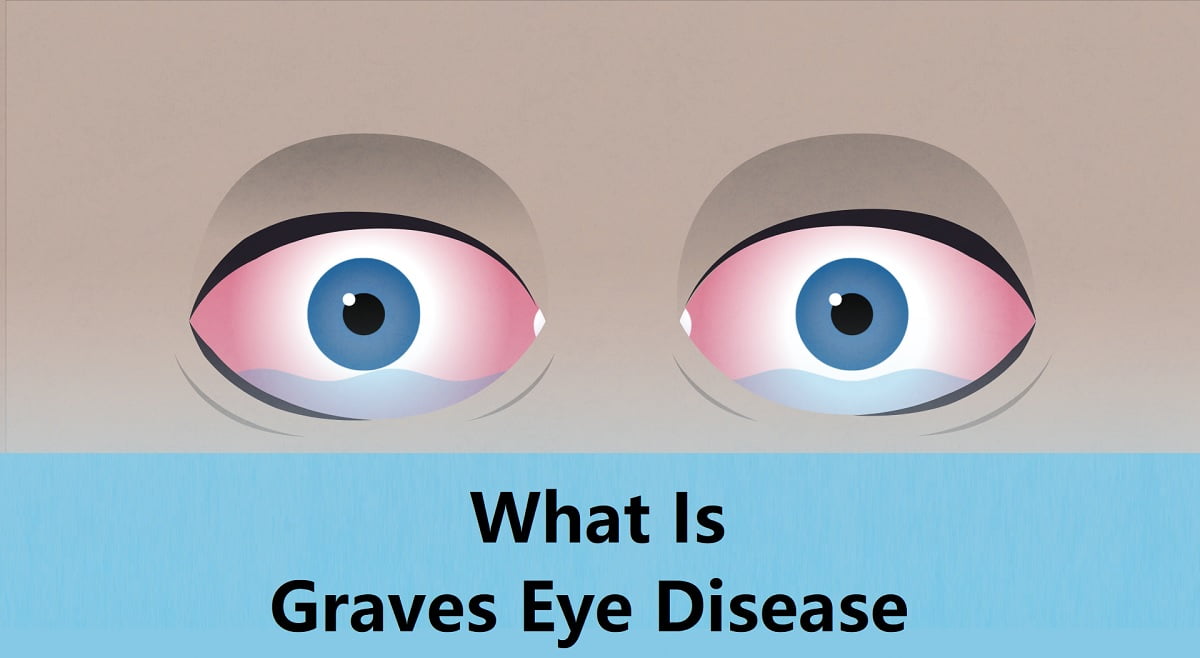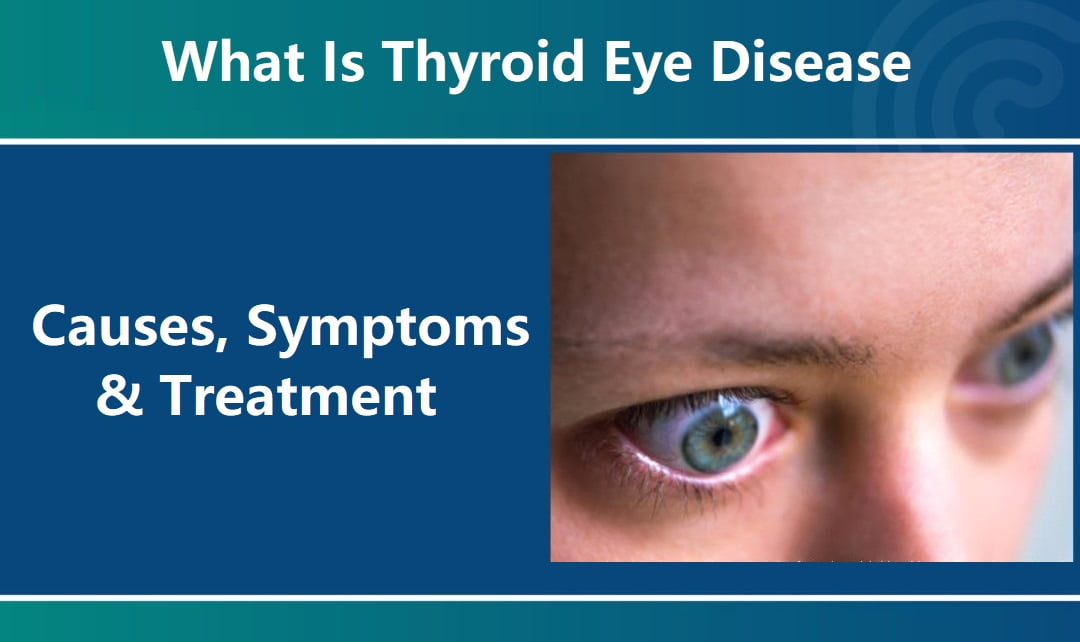Graves Eye Disease – Symptoms, Diagnosis, and Treatment 2025

Graves Eye Disease, also known as thyroid eye disease or thyroid-associated ophthalmopathy, is an inflammatory autoimmune disorder that affects the muscles and other tissues around the eyes. It is closely associated with Graves’ disease, an autoimmune condition that leads to overactivity of the thyroid gland (hyperthyroidism). Up to 50% of people with Graves’ disease will develop some degree of Graves’ eye disease.
The eyes are not directly affected by thyroid hormone levels. Rather, the condition is caused by an autoimmune reaction that stimulates the thyroid gland to produce antibodies that attack eye tissues. As a result, the tissues and muscles around the eyes become inflamed and swollen, leading to various eye problems and changes in appearance.
Although Graves’ eye disease can affect anyone with Graves’ disease, it is more common among women, people over 50, and smokers. Mild cases may cause only minor symptoms, but moderate to severe cases can cause serious eye complications and affect vision and daily functioning. Prompt diagnosis and treatment are important to prevent long-term damage to the eyes.
Symptoms of Graves Eye Disease or Thyroid Eye Disease

The signs and symptoms ofGraves’s eye disease typically develop slowly over several weeks or months. They may include:
- Eye redness, swelling, or irritation
- Excessive tearing or dry eyes
- Light sensitivity (photophobia)
- Bulging eyes (proptosis)
- Double vision (diplopia)
- Blurred vision
- Eyelid retraction, giving a starey look
- Gritty feeling or pain in the eyes
- Difficulty closing the eyelids completely (lagophthalmos)
- Eye fatigue or excessive blinking
The eye protrusion or bulging associated with Graves’ disease occurs when the eye muscles swell and push the eyes forward. One or both eyes may be affected. Other noticeable changes can include lid retraction (eyelids pulled back), eye staring, and lid lag on downward gaze.
Some patients experience inflammation of the eye tissue behind the orbit (orbital inflammation), which can cause eye or facial pain, especially with eye movement. If the optic nerve becomes compressed due to Crowding from swollen tissues, severely blurred vision or complete vision loss may occur.
The signs and symptoms are usually, but not always, symmetrical in both eyes. They tend to worsen over the first 1-3 years before stabilizing. Mild cases may involve only minor swelling and redness, while severe cases can be incapacitating.
When to See a Doctor
Consult an ophthalmologist (eye doctor) promptly if you have Graves’ disease and notice any troubling eye symptoms or changes in vision. Early diagnosis and treatment of Graves eye disease is key to preventing long-term eye problems.
Seek emergency care if you suddenly lose vision or experience very blurred vision in one or both eyes. This can indicate compressive optic neuropathy, which requires immediate treatment.
Diagnosing Graves Eye DiseaseGraves’s eye disease is usually diagnosed based on symptoms, eye exam findings, and medical history. The doctor will examine the eyes to look for characteristic signs like eyelid swelling, bulging eyes, or abnormal eye movements.
You will be asked about your medical history, including whether you have been diagnosed with or suspect you may have Graves’ disease or hyperthyroidism. Blood tests can confirm the presence of elevated thyroid hormone levels.
The following tests may be used to evaluate Graves ‘ eye disease and monitor its progression:
- Eye exam– A slit lamp exam allows the doctor to closely inspect the eyes for inflammation, protrusion, eyelid changes, and optic nerve swelling. Visual acuity and eye alignment are evaluated.
- Measurement of protrusion– Exophthalmometry measures the degree of eye bulging. X-rays or photography may document changes over time.
- Imaging– CT or MRI scans can detect swollen eye muscles and tissues pressing on the optic nerve. Ultrasound evaluates orbital tissues.
- Eye movement exam– Restricted eye movements may indicate bulging eye muscles putting pressure on nerves controlling eye movement.
- Vision testing– Visual field testing detects blind spots or vision loss. Visual acuity charts measure the sharpness of vision. Color vision may also be tested.
- Tear production test– Dry eyes are evaluated with the Schirmer test, which measures tear production.
- Eye pressure test– Increased pressure inside the eye (glaucoma) can occur if swollen tissues block drainage. This requires immediate treatment.
OnGraves’ eye disease is diagnosed, your ophthalmologist will assign a clinical severity score based on exam results. This helps guide treatment recommendations. The doctor will monitor your condition periodically to detect any worsening of symptoms over time.
Causes and Risk Factors
The exact causeGraves’aves eye disease is not fully understood. It involves an autoimmune reaction that stimulates blood vessels and tissues around the eyes, causing inflammation and fluid buildup. This swelling exerts pressure on the muscles controlling eye movement and position. It may also compress the optic nerve.
Antibodies associated with Graves’ disease, particularly the TSH receptor antibody, appear to target eye tissues in addition to the thyroid gland. This autoimmune attack triggers inflammation and overstimulates the production of glycosaminoglycans, which are compounds that help retain fluid. The excess fluid builds up in orbital tissues and eye muscles, causing many of the hallmark signs like proptosis and eyelid retraction.
Risk factors for developing Graves’ eye disease include:
- Having Graves’ disease or hyperthyroidism
- Being female
- Older age
- Family history of Graves’ eye disease
- Smoking cigarettes
- High levels of thyroid antibodies
Stress, genetics, and other autoimmune disorders may also play a role. Graves’ eye disease and dermopathy often affect the same people. The eye condition tends to develop around the same time as hyperthyroidism, but it may occur months or years before or after. The more severe the hyperthyroidism, the greater the risk of eye involvement.
For unknown reasons, up to half of people withGraves’s eye disease are euthyroid (normal thyroid functioning). Smoking is a strong independent risk factor because it appears to have toxic effects on eye tissues.
Treatment and Management
The goals of treatment for Graves ‘ eye disease are to protect the cornea, stop the progression of symptoms, reduce inflammation, and improve the patient’s appearance and quality of life. Specific treatment approaches depend on the severity of inflammation and whether eyesight is threatened by compressive optic neuropathy.
Mild cases may be managed conservatively by just lubricating the eyes and observing symptoms. Moderate to severe cases often require medical or surgical therapies:
- Lubricating eye drops– Artificial tear drops keep the eyes moist and protect the surface of the eye (cornea) from exposure. Preservative-free drops are best.
- Sunglasses– Sunglasses reduce painful light sensitivity. Wraparound frames protect eyes from dust and wind, which can irritate dry eyes.
- Immunosuppressive drugs– Corticosteroids like prednisone or methylprednisolone are a first-line treatment to control inflammation and swelling. Other drugs that suppress immune system activity may also be prescribed.
- Eyelid surgery– Surgery can release retracted eyelid muscles and tissue that mechanically pull the eyelids back abnormally. This provides eye protection.
- Orbital decompression– This surgery reduces pressure and the nd bulge in the eye by removing bony tissue from the walls of the eye socket. It improves appearance and can prevent vision loss in severe cases.
- Eye muscle/strabismus surgery– Surgery on eye muscles may improve double vision from misaligned eyes (strabismus).
- Radiation therapy– Low doses of orbital radiation can help reduce inflammation and limit progression in active moderate-to-severe cases. Multiple treatments may be given over several weeks.
Treatment is usually most effective if started in the early inflammatory stages rather than after symptoms have stabilized. You may need a combination of therapies for optimal results. After treatment, it may take months for swelling and protrusion to resolve completely. Mild residual changes often remain.
Follow your eye doctor’s recommendations for continuing eye care, lubricating drops, and sunglasses even after treatment. Also, take any prescribed medications as directed to control inflammation. Quitting smoking and achieving thyroid hormone control are beneficial. Report any new or worsening eye symptoms promptly.
The Road to Recovery
With appropriate treatment, many symptoms of Graves’ eye disease gradually resolve over 1-3 years. However, some residual damage can remain even after the active inflammation subsides. The condition stabilizes eventually, but full recovery does not always occur.
Possible long-term complications include:
- Visible eye bulging or asymmetry
- Puffy eyelids
- Persistent dry eyes
- Light sensitivity
- Reduced eye movement
- Chronic double vision
- Loss of vision from optic nerve damage (rare)
The severity of residual eye changes depends mainly on how much the eyes were affected before treatment. Some patients are left with minor symptoms, while others have continued eye protrusion, staring look, dry eyes, or double vision requiring prism glasses.
It is important to have regular follow-up exams with your ophthalmologist even after the condition becomes stable. Report any worsening or new symptoms, as they may indicate progression or other eye conditions. Protect your eyes by using lubricating drops, sunglasses, and eye shields. Take prescribed thyroid medications to maintain normal hormone levels.
Although living with residual Graves ‘ eye disease can be challenging, most patients adjust well and resume their normal activities with modest accommodations. Various surgical and nonsurgical options are available for managing persistent double vision or a staring look that is socially bothersome. An eye patch may be used to relieve diplopia. Support groups can provide helpful emotional support and coping strategies.
With proper treatment, most people with Graves’ eye disease do not experience a major loss of visual function. However, impaired quality of life is still common. By understanding your condition thoroughly and working closely with your doctors, you can achieve the best possible outcome and adaptation.
Graves’ Eye Disease FAQs
What is the difference between Graves’ disease and Graves’s eye disease?
Graves’ disease refers to an autoimmune disorder that causes hyperthyroidism or an overactive thyroid gland. Graves’ eye disease is when the autoimmune inflammation targets the tissues around the eyes, causing various eye problems. The two conditions frequently occur together.
Can you haveGraves’s eye disease without having Graves’ disease?
It is possible but uncommon. Up to half of people witGraves’es eye disease do not have overactive thyroid function. However, they nearly always test positive for thyroid antibodies associated with Graves’ disease.
Graves’ eye disease is life-threatening?
Serious complications like vision loss or impairment are possible but rare with appropriate treatment. The condition mainly threatens vision when inflammation compresses the optic nerve. It is not life-threatening in terms of mortality.
Can Graves’ eye disease be cured?
There is no known “cure” for the underlying autoimmune dysfunction, but the inflammation and symptoms can be managed and often improve significantly. With treatment, the condition usually stabilizes within 1-3 years. Some residual symptoms may remain, but major vision loss can be prevented.
How is Graves’ eye disease treated?
Mild cases may only require lubricating drops and sun protection. More severe cases call for immunosuppressive drugs like oral steroids to relieve inflammation. Surgery can help correct vision and appearance changes. Optimal outcomes often require a combination approach tailored to each patient.
Does Graves’ eye disease go away on its own?
Symptoms may gradually resolve over time without aggressive treatment. However, this process can take years and allows the inflammation to potentially cause cumulative eye damage. Proactive treatment is recommended to control symptoms sooner and limit complications.
Can Graves’ eye disease recur after treatment?
Yes, symptoms can come back and require additional treatment, even years later. Any worsening eye symptoms should be evaluated promptly to identify and address a recurrence before permanent damage can occur. Ongoing follow-up care is important.
Conclusion
Graves’ eye disease refers to inflammation and swelling of eye tissues that frequently aaccompanyGraves’ disease, an autoimmune disorder causing hyperthyroidism. Characteristic symptoms include eye bulging, lid retraction, diplopia, dry eyes, and light sensitivity.
While usually not sight-threatening, Graves’ eye disease can substantially impact daily functioning and appearance. Prompt diagnosis allows early treatment to limit damage. Mild cases may only need lubrication and sunglasses, while severe cases call for immunosuppressive therapy. Surgery can correct some vision changes and disfiguring proptosis.
Following treatment recommendations helps control inflammation so the condition can stabilize. Though challenging to live with, most patients adapt well to any residual symptoms. Ongoing eye care and doctor follow-ups are key to detecting and managing recurrences or complications. While Graves’ eye disease cannot be cured, most patients retain good vision with proper management.



